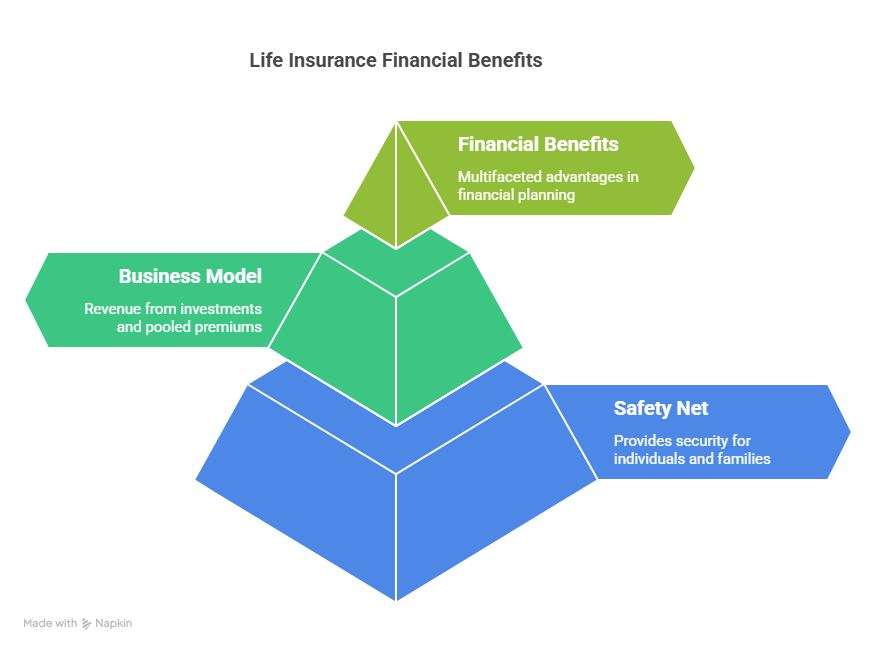Understanding the business model of life insurance companies is crucial for appreciating the financial benefits of life insurance. At its core, life insurance provides a safety net for individuals and families, while also serving as a valuable asset in one’s financial portfolio.
Life insurance companies operate by pooling premiums from policyholders and investing them to generate returns. This process allows insurers to pay out claims and maintain profitability. By grasping how life insurance companies make money, individuals can better understand the value of their policies and make informed decisions about their financial planning.
Key Takeaways
- Life insurance serves as a valuable asset in financial planning.
- Understanding the business model of life insurance companies is essential.
- Life insurance provides a safety net for individuals and families.
- Insurers generate revenue through investments and pooled premiums.
- The financial benefits of life insurance are multifaceted.

The Core Business Model of Life Insurance Companies
Understanding the core business model of life insurance companies is crucial for grasping how they function. Life insurance companies operate by collecting premiums from policyholders and managing the associated risks. This model is fundamental to their operation.
Premium Collection and Risk Assessment
Life insurance companies collect premiums from their policyholders, which is the primary source of their revenue. The process involves assessing the risk associated with each policyholder to determine the premium amount. This risk assessment is critical in maintaining the financial stability of the insurance company.
The Investment of Policyholder Premiums
The premiums collected are then invested using various life insurance investment strategies to generate returns. These investments can include bonds, stocks, and real estate, among others. The returns on these investments contribute to the growth of the life insurance cash value over time, illustrating one of the key ways life insurance can grow money.
The investment strategy is crucial as it directly impacts the insurer’s ability to pay out claims and provide returns to policyholders. Effective investment strategies can lead to higher returns, benefiting both the insurer and the policyholder.
How Life Insurance Companies Make Money
Maximizing wealth through life insurance involves understanding the diverse revenue streams of life insurance companies. These companies employ a multifaceted approach to generate revenue, balancing risk assessment, investment strategies, and policyholder behavior.
Mortality Profits: The Actuarial Advantage
Life insurance companies make money through mortality profits, which arise from the difference between actual mortality rates and the rates assumed in pricing their policies. Actuaries use historical data and statistical models to predict mortality rates, enabling companies to set premiums that ensure a profit margin.
Investment Returns and Interest Rate Spreads
Another significant revenue source is investment returns. Life insurance companies invest policyholder premiums in various assets, such as bonds, stocks, and real estate. The returns on these investments contribute to the company’s profitability, especially when the returns exceed the interest rates credited to policyholders.
Policy Lapses and Surrender Charges
When policyholders lapse or surrender their policies, insurance companies can earn revenue from surrender charges. These charges help offset the costs associated with issuing and maintaining policies.
Fees, Commissions, and Administrative Costs
Life insurance companies also generate revenue through fees and commissions. Administrative costs are often passed on to policyholders in the form of fees, contributing to the company’s revenue stream.
| Revenue Stream | Description | Impact on Profitability |
|---|---|---|
| Mortality Profits | Difference between actual and assumed mortality rates | High |
| Investment Returns | Returns on investments of policyholder premiums | High |
| Policy Lapses and Surrender Charges | Charges for early policy surrender or lapse | Moderate |
| Fees, Commissions, and Administrative Costs | Fees and commissions charged to policyholders | Moderate |
Understanding these revenue streams is crucial for generating wealth through life insurance. By balancing these factors, life insurance companies can maintain profitability while providing protection to their policyholders.
Conclusion: Balancing Profit and Protection in Life Insurance
Life insurance companies make money through a combination of premium collection, risk assessment, investment returns, and fees. Understanding how life insurance companies operate is crucial for consumers to make informed decisions about their financial protection.
The business model of life insurance is designed to balance profit and protection. By assessing risk, investing premiums, and managing policy lapses, insurers can maintain profitability while providing essential coverage to policyholders.
As the life insurance industry continues to evolve, it’s essential for consumers to stay informed about how life insurance companies make money. This knowledge enables individuals to navigate the market effectively and choose policies that meet their needs and budget.
FAQ
How does life insurance generate cash value?
Life insurance generates cash value through a combination of premium payments and investment returns. A portion of the premiums paid is invested, and the returns are added to the policy’s cash value, allowing it to grow over time.
What are the financial benefits of having a life insurance policy?
The financial benefits of having a life insurance policy include a death benefit paid to beneficiaries, tax-deferred growth of cash value, and the potential to borrow against the policy’s cash value. Additionally, some policies offer dividend payments to policyholders.
How can life insurance be used as an asset in financial planning?
Life insurance can be used as an asset in financial planning by providing a source of tax-free funds through loans or withdrawals, supplementing retirement income, and serving as a tool for estate planning and wealth transfer.
What are some common life insurance investment strategies?
Common life insurance investment strategies include investing in a variety of assets, such as stocks, bonds, and mutual funds, through the insurance company’s general account or separate accounts. Some policies also offer indexed or variable investment options.
How do life insurance companies make money from policyholder premiums?
Life insurance companies make money from policyholder premiums by investing the premiums and earning returns, charging fees and administrative costs, and benefiting from mortality profits and interest rate spreads.
Can life insurance help maximize wealth?
Yes, certain types of life insurance, such as whole life or universal life insurance, can help maximize wealth by providing a tax-deferred savings component and potentially generating returns through investments.
What happens to the cash value of a life insurance policy over time?
The cash value of a life insurance policy typically grows over time as premiums are paid and investment returns are credited to the policy. However, the cash value can be affected by factors such as policy loans, withdrawals, and fees.
How do fees and commissions impact the cash value of a life insurance policy?
Fees and commissions can reduce the cash value of a life insurance policy, as they are typically deducted from the premiums paid or the policy’s cash value. Understanding the fee structure of a policy is essential to maximizing its cash value.



